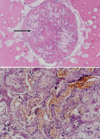Neoplasms of Bone and Joint Pathology Flashcards
How does the diagnosis of bone tumors differ from other tissues?
histology comes last
What is osteochondroma?
benign cartilaginous lesion and most common benign tumor
contains marrow space contiguous with the underlying medulla of the bone
mutation in suppressor gene EXT1 that affects growth plate kinetics
Multiple Hereditary Exostosis
AD disorder resulting in multiple osteochondromas
caused by biallelic inactivation of EXT1 and EXT2
malignant transformation (2-3% of cases) mostly into chondrosarcomas
What is the clinical presentation of osteochondroma?
peak is in 1st and 2nd decades
male-female ratio is 2:1
located in the distal femur, proximal humerus, and proximal tibia (>50%)
What are the x-ray findings of osteochondroma?
cartilaginous cap on bony stalk that is continuous with medulla of bone
tumor grows away from growth plate (cap size>3cm. suggests malignant transformation)
“arc and ring” calcifications

What is the treatment and prognosis of osteochondroma?
no treatment unless symptomatic or there is evidence of possible secondary chondrosarcomatous transformation of the cartilaginous cap
1-2% recur, 1-3% of solitary and up to 5% of multiple osteochondroma undergo malignant transformation
mostly chondrosarcoma
What are the histological features of osteochondroma?
cartilaginous “cap” shows features of normal growth plate cartilage
stalk of tumor contiguous with intramedullary portion of bone and composed of normal marrow elements

What is osteoid osteoma?
small benign bony process < 2 cm
What is the clinical presentation of osteoid osteoma?
increasing nocturnal pain relieved by ASA/NSAID (80% of patients)
any bone except skull/sternum, 50% involve femur and tibia
mostly in 2nd and 3rd decades, rare after 30 years of age
male-female ratio is 2:1
What is the radiological findings in osteoid osteoma?
zone of sclerotic bone surrounding a well-demarcated lucent focus (the “nidus”) composed of woven bone in a vascular stroma

What is the prognosis of osteoid osteoma?
excellent, but must remove nidus

What are the histological features of osteoid osteoma?
the “nidus” (arrows) is the radiolucent central focus of woven bone within a vascular stroma
the surrounding cortical bone is thickened (top)
nidus consists of woven bone with osteoblastic rimming and a highly vascular stroma (right, bottom)

What is enchondroma?
benign hyaline intramedullary cartilaginous neoplasm
**periosteal chondroma is located on the cortical surface under the periosteum
What is the clinical presentation of enchondroma?
2nd to 4th decades, M=F
located in the finger and toes in 50% of cases
proximal humerus, proximal and distal femur
What are the radiologic findings of enchondroma?
well-circumscribed, lucent with cartilage matrix calcification
“arc and ring” due to enchondral bone formation at periphery of tumor nodule

What is the prognosis of enchondroma?
observation with serial radiographs
curettage (<5% recurrent state)
What are the histological findings of enchondroma?
nodules of mature cartilage within a fatty bone marrow (top)
note low cellularity or lack of pleomorphism (bottom)
benign chondrocytes evenly distributed or arranged in clusters

What is multiple enchondromata?
non-hereditable disorder characterized by multiple enchondromas (usually affects same region of body)
incidence of malignant transformation is 15%-50%
unilateral distribution in the appendicular skeleton
Ollier’s disease
multiple enchondromata
Maffuci’s syndrome
multiple enchondromata + soft tissue/visceral vascular tumor (mainly, hemangiomas)
What is giant cell tumor of bone?
locally aggressive neoplasm
tumor composed of osteoclasts and neoplastic spindle cells
What is the clinical presentation of giant cell tumor of bone?
peak in 3rd decade (skeletally-mature), F>M (~3:2)
located in the distal femur, proximal tibia, distal radius, proximal humerus (single/multiple GCT in odd sites -> hyperparathyroidism)
What are the radiologic features of giant cell tumor of bone?
eccentric, lytic lesion that may involve soft tissue (extends from metaphysis into epiphysis once growth plate closes)

What is the prognosis of giant cell tumor of bone?
en bloc excision is prefferred
high recurrence rate (25%-60%) if curetted
<5% of GCT metastasize to lung (histology can’t predict clinical course)
sarcomatous transformation is rare (usually follows radiotherapy)











